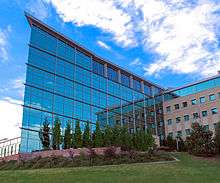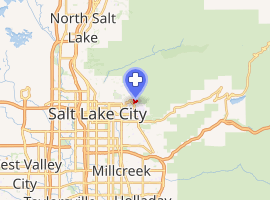Huntsman Cancer Institute
Huntsman Cancer Institute (HCI) is a nationally recognized cancer research center and treatment hospital at the University of Utah (U of U). As the only National Cancer Institute (NCI) designated Comprehensive Cancer Center in the Mountain West, HCI serves the largest geographic region of all cancer centers, covering Utah, Idaho, Montana, Nevada, and Wyoming.
| Huntsman Cancer Institute | |
|---|---|
 | |

| |
| Geography | |
| Location | Salt Lake City, Utah, United States |
| Coordinates | 40.7725°N 111.8345°W |
| Organization | |
| Care system | Public |
| Type | Teaching |
| Affiliated university | University of Utah |
| Links | |
| Website | http://www.huntsmancancer.org/ Official |
| Lists | Hospitals in Utah |
Overview
HCI’s mission is to understand cancer from its beginnings, to use that knowledge in the creation and improvement of cancer treatment, to relieve the suffering of cancer patients, and to provide education about cancer risk, prevention, and care.
With a guiding principle of “patient and community first,” all aspects of HCI are designed to ease the burden of patients and families. HCI’s patient satisfaction scores are routinely in the top one percentile nationwide.
The cancer center’s roots lie in the Utah Regional Cancer Center, which originally received NCI Cancer Center designation in 1986. Following a major donation from the Jon M. and Karen Huntsman family, the center was renamed Huntsman Cancer Institute in 1995.
Timeline
- 1996: HCI breaks ground on their first 231, 118-square-foot research, treatment, and education facility.
- 1997: HCI joins the National Cancer Center Network (NCCN), a not-for-profit alliance of the world’s leading cancer centers dedicated to improving the quality and effectiveness of care provided to patients with cancer.
- 1999: The Jon M. Huntsman Research Center is dedicated and patient clinics open.
- 2000: Jon M. and Karen Huntsman pledge $125 million to fund cancer research and construct the HCI Cancer Hospital.
- 2001: HCI breaks ground on its first 50-bed cancer specialty hospital.
- 2004: HCI Cancer Hospital opens, along with the first full-field digital mammography unit, first PET/CT imaging unit, and first facial prosthetics lab in the Mountain West.
- 2005: HCI and Intermountain Healthcare join forces to create the Huntsman-Intermountain Cancer Care Program, opening research opportunities to advance cancer care.
- 2006: Mary Beckerle, PhD is named the director of HCI. Of the 62 cancer centers recognized by the NCI at this time, only five of them were led by women.
- 2008: HCI breaks ground on a hospital expansion that will double capacity for patients.
- 2011: The new 156,000-square-foot hospital expansion opens to patients.
- 2014: HCI breaks ground on its cancer research center expansion: Primary Children’s and Families Cancer Research Center.
- 2015: NCI awards HCI Comprehensive Cancer Center status, the highest national designation possible.
- 2017: HCI opens the 220,000-square-foot Primary Children’s and Families Cancer Research Center.
- 2018: HCI breaks ground on the first Proton Therapy Center in the Mountain West, naming it in honor of U.S. Senator Orrin G. Hatch.
- 2019: HCI breaks ground on the Kathryn F. Kirk Center for Comprehensive Cancer Care and Women’s Cancers.
Research
HCI coalesces the work of more than 200 cancer research teams, and is organized into four research programs that work in an environment of collaborative exchange: Nuclear Control of Cell Growth and Differentiation, Cell Response and Regulation, Experimental Therapeutics, and Cancer Control and Population Sciences. Ten Disease-Oriented Research Teams (DOTs) provide a forum to promote translational research across the programs.
One of the main research focuses of HCI is cancer genetics. HCI manages the Utah Population Database (UPDB), which is the largest database of its kind in the world. The UPDB houses information on more than nine million people linked to genealogies, health records, and vital statistics. This information helps researchers look for genetic patterns of cancer in families, and is used to inform research in precision cancer prevention and personalized cancer treatments.
Training
Part of HCI’s mission is to train and educate the next generation of individuals committed to stopping cancer. Training programs span age groups and specialties, from clinical to research, beginning with high school students.
Community Outreach and Engagement
HCI is committed to addressing cancer-related needs of the diverse residents of Utah and the Mountain West. Community Outreach and Engagement assesses Utah’s cancer needs, conducts research relative to HCI’s catchment area, engages and informs the community, and builds long-standing partnerships with organizations throughout the region.